The entertainment industry owes a lot to photonics: From laser light displays at concerts to new lens technology for 3-D and other special effects in movies, photonics adds the “wow” factor, thrilling and delighting audiences around the world.
Laser light shows go back almost as far as the laser itself. But thanks to technological advances, simplified setups and dramatically lower cost, laser light shows have spread from the occasional permanent attraction and Pink Floyd concerts to theme parks, theaters, casinos, musicals, planetariums, hotel resorts, cruise liners, sports, arts and other big events.
“Even though lasers are used for myriad important applications, as evidenced in every issue of this magazine, the public often underestimates their critical roles in modern life,” said Andreas Zuck, market development manager at Coherent Inc. in Santa Clara, Calif. “As just one example, lasers have an enabling impact on just about every aspect of manufacturing today’s electronics, like smartphones and tablets. Yet, for many people, the laser light show is the only time they see a laser ‘in action.’ ”
Rent a laser light show
Probably the most influential factor in the growing popularity of laser entertainment is the reduction in the costs of laser technology. Evidence of this can be seen in the ongoing growth in the rental business for concert tours and temporary installations.
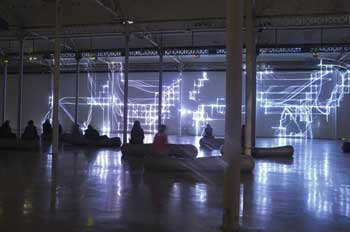
Fragile Territories, an art project exhibited in Nantes, France, from November 2012 to
January 2013; used four white lasers to create slowly evolving shapes, edges and curves of
shimmering pulsating light on a wall.
In the past, laser light show equipment could easily fetch a few hundred thousand dollars. Now, with more affordable technology, and the purchase price of a basic laser projector and its control software and hardware starting at a few thousand dollars, light shows are popping up all around us.
Special-effects companies that formerly stayed away from lasers are now combining them with effects including pyrotechnics, video, fog, water fountains and other lighting such as LEDs to produce a true multimedia show.
“Not too long ago, putting on a laser show required a very large budget, a multitude of equipment and, in many ways, was quite a hassle to put on,” said William R. Benner Jr., president and CTO of Pangolin Laser Systems Inc. in Orlando, Fla.; the company designs software and systems for laser displays. “Now, a laser projector is quite easy to set up – requiring only power and a control connection – and the costs have come down tremendously.”
Technological improvements
Migration from water-cooled ion lasers to optically pumped semiconductor lasers (OPSLs) has brought power and wavelength scalability, leading to a broader range of wavelengths than any previous technology. Currently, OPSLs for the entertainment market are offered at 10 wavelengths and up to 20 W of output power from Coherent Inc.
“This has enabled the development of affordable, compact, maintenance-free and air-cooled multicolor laser scanners with longer lifetimes, better reliability and constant performance,” Coherent’s Zuck said. “For the audience, this means far more use of full-color graphics and effects than ever before with a broader gamut (range) of colors.”
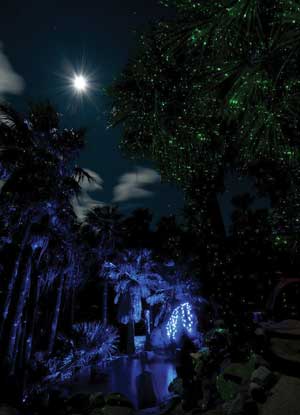
More than mood lighting: Installations including BlissLights projectors can be used to transform exteriors with thousands of points of light.
Increased scanning speed also is bringing light show graphics to life. For the past 35 years, laser graphics have mainly consisted of cartoonlike images – reminiscent of neon signs – because of the limited speed offered by galvanometer scanners.
Faster scanners allow the imagery to be more complex – effectively allowing laser light shows to leave the realm of cartoons. Faster scanners also enable any imagery to be displayed without flicker – a nuisance that has plagued the light-show industry for decades.
And when laser show projectors are used for audience scanning (a practice where the laser is projected directly into the audience, creating emotive patterns and shapes), faster scanning promotes an even greater degree of eye safety.
Another significant advancement in the laser entertainment industry has been in laser control technology, which has come to market in recent years.
“Two of the most important elements to laser displays are optical scanners and laser control software and hardware,” Pangolin’s Benner said. “The laser control software allows the operator to
design and create a laser show.
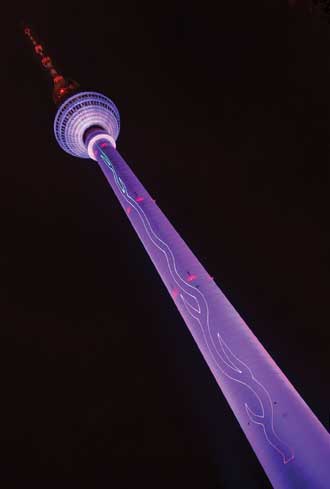
Animated graphics of growing plants by Laser-Animation Sollinger GmbH were projected on the 200-m shaft of the Berlin Radio Tower during the Festival of Lights 2012 in Berlin.
“The hardware then sends this pattern created by the laser software to the laser projector and scanners, and the scanners then direct the beam, so that the image can be displayed.”
Companies such as Pangolin, with its new ScannerMAX division, are paving the way in both regards. Pangolin has developed a complete series of laser control software and hardware, making it easier to create customized laser light shows for all sorts of events and productions.
“As a result of these technological improvements, the wonderful world of laser display is being shared with a much broader audience now, helping more and more people enjoy this beautiful effect,” Benner said. “Laser displays are now being used everywhere, from notable events like the Grammys, Super Bowl
and Olympic Games to high-profile concerts and tours, nightclubs and even television, movies and corporate events.”
In the future, we can expect to enjoy more colors and higher power, allowing improved performance as well as better visibility and brightness for long-throw beam and graphic shows. But one of the most exciting advances is the new green “direct diode” from companies such as Osram GmbH of Munich, which promises to further reduce costs within the industry.
Photonics creates blissful effects
At aesthetic laser projector maker BlissLights Inc. of Escondido, Calif., diode-pumped solid-state lasers are
combined with multiphase diffractive holographic optics, superluminous diodes and precision motors to create unique lighting effects such as cloud nebulae and star fields.
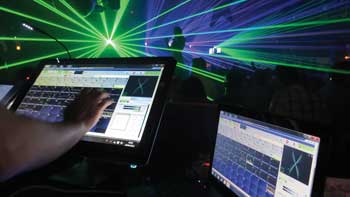
As laser technology and software become less expensive, light shows are becoming easier to produce at nightclubs and elsewhere.
Used to illuminate the interiors of restaurants, discos, nightclubs, concert halls, event ballrooms, tent venues, theaters and museums, lasers can project thousands of pinpoints of light that look and move like the stars of the universe. They also can illuminate exteriors, transforming the sides of buildings, landscapes, trees, waterfalls and fountains.
“The star-field effect is accomplished by using a high-efficiency holographic grating and a laser. The optical path typically includes one stationary grating and another grating mounted to a fractional motor producing a slowly moving star-field effect,” said Randy Johnson, chief inventor and co-founder of BlissLights. “The blue nebula cloud effect is produced using an LED with a slowly moving texture wheel and focusing lenses.”
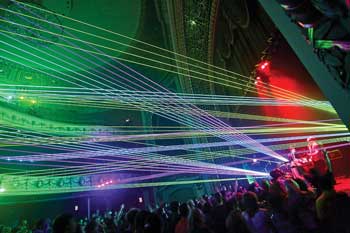
An overhead beam show during the Ghostland Observatory concert at the Pabst Theater in Milwaukee.
The BlissLights Starfield Projector was installed recently in Japan’s Universal Studios Space Fantasy ride. The scanning setup engulfs the audience in waves of laser beams to induce a feeling of motion and transportation.
In another unique creation, the company’s Pixie Dust cleverly demonstrates Newtonian physics using particles of light and applying forces such as mass, gravity, density, velocity and collision to display the laws of physics.
Such “blissful” effects are also being put to good use in schools for children with autism, enabling them to realize a greater sense of calm. BlissLights has also donated products to the Make-a-Wish Foundation to decorate the rooms in which the children express their wishes.
Such effects have also made their way onto the ceilings of dental offices and into MRI facilities to help relax patients.
And the Oscar goes to … photonics
At the beginning of the year, lens maker Cooke Optics Ltd. of Leicester, England, picked up an Academy Award of Merit at the Scientific and Technical Awards ceremony in recognition of its “continuing innovation in design, development and manufacture of advanced camera lenses that have helped define the look of motion pictures over the last century.”
“It’s a tremendous honor to receive this award from the academy, after Cooke’s 127 years’ continuous service to the motion picture industry,” said Les Zellan, chair and owner of Cooke Optics.
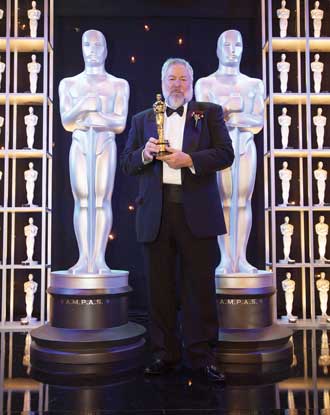
Les Zellan, chairman and owner of Cooke Optics, poses with the company’s Academy Award of Merit presented Feb. 9, 2013.
Cooke’s lenses add a warm, natural feel to the images on the screen, pleasing the eye and providing dimensionality and high contrast.
“Our recipe for the tuning of the lens is one of our trade secrets, but the results speak for themselves in that our lenses create a warm, flattering look, particularly for skin tones,” Zellan said. “It is very dimensional and gives a ‘round,’ organic look that has been a consistent element of Cooke lenses since our early days and has evolved into the famed ‘Cooke Look.’ ”
Cooke lenses have been used on recent film projects including Zero Dark Thirty, A Good Day to Die Hard, After Earth, Hugo, Midnight in Paris, My Week with Marilyn and Extremely Loud and Incredibly Close.